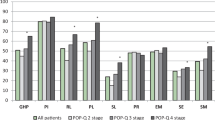Abstract
Introduction and hypothesis
The aim of this study was to evaluate the validity and reliability of a Persian translation of the Prolapse Quality-of-Life (P-QOL) questionnaire in women with pelvic organ prolapse (POP).
Methods
One hundred and twenty-four women with POP symptoms and 125 asymptomatic women were studied. The asymptomatic group was used for discriminant validity.
Results
Seventy-two percent (89/124) of the symptomatic women had stage ≥2 POP while 86% (108/125) of the asymptomatic women had a stage <2 POP. All domains of the Persian P-QOL have a Cronbach’s alpha coefficient greater than 0.7 (0.78–0.97) and were significantly different between symptomatic and asymptomatic women indicating a good discriminant validity (<0.01). The test–retest reliability confirmed a highly significant correlation. All items of P-QOL questionnaire correlated significantly with the objective vaginal examination findings (construct validity) except for personal relationship and emotions.
Conclusion
The Persian version of the P-QOL is a valid and reliable tool to assess QOL of women with POP.

Similar content being viewed by others
References
Digesu GA, Khullar V, Cardozo L, Robinson D, Salvatore S (2005) P-QOL: a validated questionnaire to assess the symptoms and quality of life of women with urogenital prolapsed. Int Urogynecol J Pelvic Floor Dysfunct 16:176–181
Bump RC, Norton PA (1998) Epidemiology and natural history of pelvic floor dysfunction. Obstet Gynecol Clin North Am 25:723–746
Swift SE (2000) The distribution of pelvic organ support in a population of female subjects seen for routine gynecologic health care. Am J Obstet Gynecol 183:277–285
Samuelsson EC, Arne Victor FT, Tibblin G, Svardsudd KF (1999) Signs of genital prolapse in a Swedish population of women 20–59 years of age and possible related factors. Am J Gynecol 180:299–305
Burrows L, Meyn L, Walters M, Weber A (2004) Pelvic symptoms in women with pelvic organ prolapse. Obstet Gynecol 104:982–988
Bradley C, Nygaard I, Initiative WH (2005) Vaginal wall descensus and pelvic floor symptoms in older women. Obstet Gynecol 106:759–766
Claerhout F, Moons P, Ghesquiere S, Verguts J, De Ridder D, Deprest J (2010) Validity, reliability and responsiveness of a Dutch version of the prolapse quality-of-life (P-QoL) questionnaire. Int Urogynecol J Pelvic Floor Dysfunct 21(5):569–578
Manchana T, Bunyavejchevin S (2010) Validation of the Prolapse Quality of Life (P-QOL) questionnaire in Thai version. Int Urogynecol J Pelvic Floor Dysfunct 21(8):985–993
Svihrova V, Digesu GA, Svihra J, Hudeckova H, Kliment J, Swift S (2010) Validation of the Slovakian version of the P-QOL questionnaire. Int Urogynecol J Pelvic Floor Dysfunct 21(1):53–61
de Oliveira MS, Tamanini JT, de Aguiar CG (2009) Validation of the Prolapse Quality-of-Life Questionnaire (P-QoL) in Portuguese version in Brazilian women. Int Urogynecol J Pelvic Floor Dysfunct 20(10):1191–1202
Lenz F, Stammer H, Brocker K, Rak M, Scherg H, Sohn C (2009) Validation of a German version of the P-QOL Questionnaire. Int Urogynecol J Pelvic Floor Dysfunct 20(6):641–649
Fukumoto Y, Uesaka Y, Yamamoto K, Ito S, Yamanaka M, Takeyama M, Noma M (2008) Assessment of quality of life in women with pelvic organ prolapse: conditional translation and trial of P-QOL for use in Japan. Nippon Hinyokika Gakkai Zasshi 99(3):531–542
Cam C, Sakalli M, Ay P, Aran T, Cam M, Karateke A (2007) Validation of the prolapse quality of life questionnaire (P-QOL) in a Turkish population. Eur J Obstet Gynecol Reprod Biol 135(1):132–135
Digesu GA, Santamato S, Khullar V et al (2003) Validation of an Italian version of the prolapse quality of life questionnaire. Eur J Obstet Gynecol Reprod Biol 106(2):184–192
Bump RC, Mattiasson A, Bo K, Brubaker LP, DeLancy JO, Klarskov P et al (1996) The standardization of terminology of female pelvic organ prolapse and pelvis floor dysfunction. Am J Obstet Gynecol 175:10–17
Haylen BT, de Ridder D, Freeman RM et al (2010) An International Urogynecological Association (IUGA)/International Continence Society (ICS) joint report on the terminology for female pelvic floor dysfunction. Int Urogynecol J Pelvic Floor Dysfunct 21(1):5–26
Digesu GA, Khullar V, Cardozo L, Robinson D (2008) Interobserver reliability of digital vaginal examination using a four grade scale in different patient positions. Int Urogynecol J Pelvic Floor Dysfunct 19:1303–1307
Srikrishna S, Robinson D, Cardozo L, Gonzalez J (2008) Is there a difference in patient and physician quality of life evaluation in pelvic organ prolapse? Int Urogynecol J Pelvic Floor Dysfunct 19:517–520
Fayyad A, Hill S, Gurung V, Prashar S, Smith ARB (2007) How accurate is symptomatic and clinical evaluation of prolapse prior to surgical repair? Int Urogynecol J Pelvic Floor Dysfunct 18:1179–1183
Digesu GA, Salvator S, Chaliha C, Athanasiou S, Milani R, Khullar V (2007) Do overactive bladder symptoms improve after repair of anterior vaginal wall prolapse? Int Urogynecol J Pelvic Floor Dysfunct 18:1439–1443
Kelleher CJ, Cardozo LD, Khullar V, Salvatore S (1997) A new questionnaire to assess the quality of life of urinary incontinent women. Br J Obstet Gynecol 104:1374–1379
Fayyad AM, Redhead E, Awan N, Kyrgiou M, Prashar S, Hill SR (2008) Symptomatic and quality of life outcomes after site-specific fascial reattachment for pelvic organ prolapse repair. Int Urogynecol J Pelvic Floor Dysfunct 19:191–197
Acknowledgments
Our special thanks to the head of the Department of Gynecology and Obstetrics, the Akbar-Abadi hospital, Maryam Kashanian M.D., and all gynecology and obstetric residents for their collaboration.
Conflicts of interest
None.
Author information
Authors and Affiliations
Corresponding author
Rights and permissions
About this article
Cite this article
Nojomi, M., Digesu, G.A., Khullar, V. et al. Validation of Persian version of the Prolapse Quality-of-Life questionnaire (P-QOL). Int Urogynecol J 23, 229–233 (2012). https://doi.org/10.1007/s00192-011-1529-6
Received:
Accepted:
Published:
Issue Date:
DOI: https://doi.org/10.1007/s00192-011-1529-6




